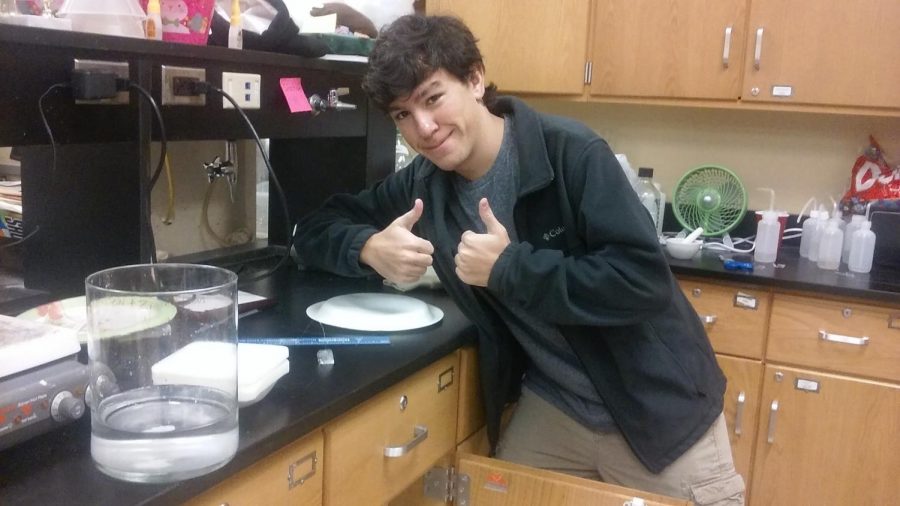A Clear Shot at Victory in the Crystal Growing Competition
Credit to David Hernandez
Junior Riley Lawson poses with his crystal as he checks it one last time before having it sent to the University of Rochester.
Published: December 4, 2017
It takes about 24 hours to thaw a turkey, but as many began this process over the Thanksgiving Break, on Nov. 21 the end of a much longer process took place in the Chemistry lab in room 182. The Science Club began its Third Annual Crystal Growing Competition on Oct. 24. Eight teams participated to grow the largest and best quality alum crystals in the school, and then the best were sent to the University of Rochester in New York to be judged to win the $200 cash prize.
“I did it two years ago,” said junior Riley Lawson, who participated in the competition with junior Sarah Zimmerman. “It’s really fun, it’s a chance for us to get more involved with doing science. It’s a long term experiment that we are able to do with anybody in the club, which is super fun.”
Participants worked to create a solution of water and aluminum potassium sulfate (alum) in the beginning. The real complexity of the challenge was figuring out the perfect ratio to ensure proper crystal growth. In the next few days small seed crystals would form at the bottom of the solution. Groups would take the seed crystals and have them suspended over the solution so that the crystal would grow more layers.
“As water evaporates the solution becomes more supersaturated and that’s when the seed crystal can get bigger,” said Chemistry teacher and Science Club sponsor Donna Malkmus. “Or if it loses too much water too rapidly, then you get more seed crystals on the bottom, which is what you’re trying to prevent.”
To ensure constant crystal growth participants regularly checked in the morning or the afternoon and some even took time out of classes to see if their crystal grew larger in size or if more seed crystals formed at the bottom of the solution. If more seed crystals formed they would then be dissolved in the solution and a slight adjustment to the water level would be made.
“It’s really on them,” said Malkmus. “The teams that do the best are the ones that are meticulous about coming in before school and after school almost every single day. The two teams that I’ve had doing the best right now have been diligent about coming in. Somebody on their team had been coming in every single day and that’s what it takes for a month.”
This year Malkmus has seen some of the best growth from the team of seniors Grant Freitas and Caitlind Walker who checked up on their crystal constantly during the school days in the morning and during classes. Their hard work resulted in a beautiful crystal with little imperfections in quality and fairly large size. Another notable team of Lawson and Zimmerman who grew a very large and fairly transparent crystal using their careful diligence and time out of many classes to perfect their solution.
“I feel like it turned out pretty well,” said Freitas. “No matter how well we do with the actual competition, I’m pretty happy with how it turned out.”






![FHN Holds Prom at Old Hickory Country Club [Photo Gallery]](https://FHNtoday.com/wp-content/uploads/2024/04/Brewer_stopmotion-9-300x200.jpg)

![FHN Students Watch the Solar Eclipse [Photo Gallery]](https://FHNtoday.com/wp-content/uploads/2024/04/4.8.24-solar-eclipse_-300x200.jpg)
![FHN Boys Varsity Volleyball Team Goes Against Troy [Photo Gallery]](https://FHNtoday.com/wp-content/uploads/2024/03/IMG_7545-300x200.jpg)
